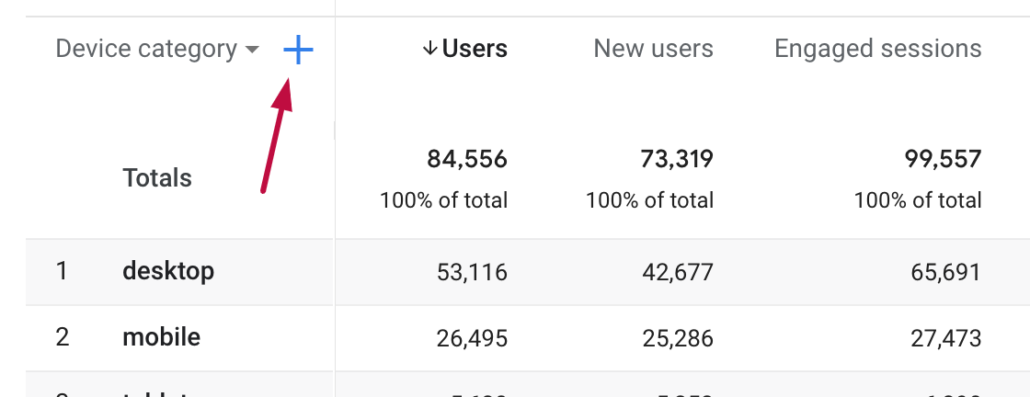Secondary Dimension in Google Analytics: Best Practices and Tips
Secondary Dimension in Google Analytics: Best Practices and Tips
Blog Article
Transform Your Analytics Approach With Second Measurement in Google Analytics
By incorporating second measurements right into data evaluation, a new layer of understandings emerges, shedding light on complex user actions and communications. The strategic application of second dimensions holds the vital to unlocking a prize trove of invaluable info that can transform how services interpret and act upon their data.
Recognizing Secondary Measurements in Google Analytics
Second dimensions in Google Analytics provide extra context to key data by permitting users to examine metrics throughout a second measurement, offering deeper understandings into individual behavior and communications on an internet site. Secondary Dimension in Google Analytics. While main measurements provide fundamental information points such as pageviews, bounce price, and session duration, additional measurements supply a more in-depth sight by segmenting the key data even more. This division permits customers to analyze metrics in combination with one more measurement, such as website traffic sources, demographics, or user habits
Advantages of Making Use Of Second Measurements
Utilizing secondary dimensions in Google Analytics provides a calculated benefit by enhancing the depth of analysis and offering a much more thorough understanding of user interactions and habits on a web site. By including second dimensions, analysts can get beneficial insights into the performance of particular sections or variables within their information. This makes it possible for a more detailed evaluation of individual habits beyond surface-level metrics, enabling for a deeper exploration of the elements influencing user engagement and conversions.

Just How to Carry Out Secondary Measurements
When including secondary dimensions in Google Analytics, one essential step is to choose the pertinent metrics and dimensions to enhance the evaluation procedure. Clicking on this button will open up a drop-down food selection listing various dimensions that can be included to your key dimension for deeper understandings.
After picking the appropriate additional measurement, such as 'Source/Medium' or 'Tool Category,' Google Analytics will show the information in an extra comprehensive style, enabling you to cross-analyze various aspects of customer actions. Keep in mind to explore various combinations of primary and additional measurements to uncover valuable patterns and trends that can inform your advertising methods. By applying secondary dimensions thoughtfully, you can acquire a much more comprehensive understanding of your site or app efficiency and make data-driven click here for more info decisions to enhance your electronic visibility.
Studying Data With Additional Measurements
Boost your information analysis in Google Analytics by including secondary dimensions to dig deeper into customer actions patterns and enhance your electronic advertising and marketing strategies effectively - Secondary Dimension in Google Analytics. By including additional dimensions to your key information, you can acquire valuable understandings that can assist you make notified decisions concerning your site or application efficiency
Evaluating information with additional dimensions enables you to segment your main data better, supplying a more thorough sight of user communications. Combining the key dimension of 'source/medium' with a secondary dimension like 'touchdown page' can disclose which particular web pages are driving traffic from different resources. This information can be critical in refining your material strategy or enhancing your marketing campaign to raise conversions.
Additionally, making use of secondary dimensions allows you to identify connections in between different metrics, assisting you comprehend the influence of different official statement aspects on customer habits. Whether it's examining demographics alongside customer engagement metrics or device categories with conversion rates, second measurements empower you to discover covert trends and patterns that can lead your marketing efforts.
Enhancing Efficiency With Second Measurements
To enhance the efficiency of data analysis and decision-making in Google Analytics, incorporating second dimensions is vital to optimizing efficiency metrics and gaining much deeper insights into customer habits patterns. By using secondary dimensions, analysts can dig beyond surface-level data and uncover important relationships that might or else go undetected. This optimization strategy enables services to tailor their advertising efforts better, identify locations for renovation in web site functionality, and improve overall user experience.
Second measurements provide a more comprehensive sight of individual interactions by providing added context to main data metrics. As an example, coupling the key dimension of 'landing web page' with an additional dimension like 'tool classification' can expose whether certain tools are more probable to drive engagement on specific touchdown web pages. This insight can educate receptive design improvements or targeted marketing techniques to boost performance.

Conclusion
In conclusion, the integration of second dimensions in Google Analytics offers companies with a powerful device to improve their analytics technique. Secondary Dimension in Google Analytics. By diving deeper right into customer habits and interactions, marketers can reveal useful insights that can drive efficiency optimization and enhance the overall customer experience. Leveraging additional dimensions permits for a more thorough evaluation of data, causing more enlightened decision-making and tailored advertising and marketing efforts
Secondary measurements in Google Analytics offer added context to primary information by allowing individuals to analyze metrics throughout a 2nd dimension, supplying deeper understandings right into individual actions and interactions on a site. While key dimensions supply basic data factors such as pageviews, bounce price, and session duration, secondary have a peek at this site dimensions provide a more in-depth sight by segmenting the main data additionally.One of the crucial advantages of utilizing second dimensions is the capability to reveal relationships and patterns that may not be promptly apparent when evaluating data with main measurements alone.When including second dimensions in Google Analytics, one vital action is to choose the pertinent metrics and measurements to improve the analysis process. Pairing the primary dimension of 'landing page' with an additional dimension like 'gadget classification' can expose whether specific gadgets are a lot more most likely to drive interaction on certain touchdown web pages.
Report this page